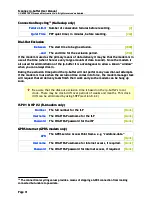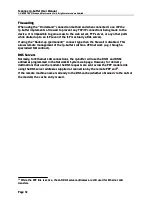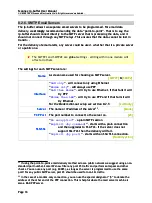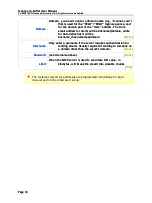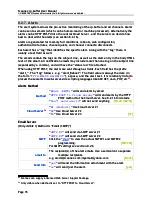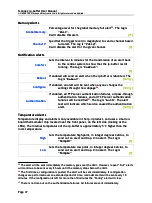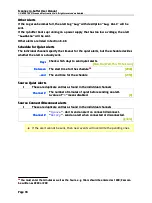
Scannex ip.buffer User Manual
© UK 2007-2021 Scannex Electronics Ltd. All rights reserved worldwide.
SNMP Traps
Destination
Dotted IP address for SNMP traps.
[255.255.255.255]
“
0.0.0.0
” will disable SNMP trap transmission
“
255.255.255.255
” will broadcast traps across the LAN
Can also be a list of names or IP addresses (firmware 2.82+).
SNMP traps are sent in SNMP v1 format. The MIB definitions for the ip.buffer and NetBuffer
are available from Scannex.
Firmware 2.82 allows for up to 16 trap destinations to be entered as a list
. Separate each
address with a comma, a semicolon, or a space.
e.g. “
192.168.0.123,127.0.0.1,10.0.0.123
”
When sending a powerfail trap the ip.buffer may only be able to send to the
first destination. If powerfail traps are critical then ensure the most important
destination is entered first.
If a broadcast address is used along with a local address then duplicate traps
will be received by the PC. e.g. “
255.255.255.255,192.168.0.123
” - the
address 192.168.0.123 will receive duplicate traps.
SNMP Agent
UDP Port
The port for the agent. Set to zero (0) to disable SNMP Agent
completely.
[161]
Community
The SNMP community name. This value is shared between all
SNMP activities and modules.
[public]
Name override
The name to return for sysName. If left blank this will default to
the string “
ip.buffer-00-02-ae-xx-xx-xx
” (the
serial number)
[blank]
Contact
A contact name, number, or email. This value is simply reported
back to the SNMP agent when querying the sys information
group.
[blank]
Location
A location for this device. This value is simply reported back to
the SNMP agent when querying the sys information group.
[blank]
See section 17 for details on the complete SNMP OID values.
7
If you need to receive the “Power Off” trap, make sure the most important server is listed first.
Depending on the network conditions the ip.buffer may not be able to transmit to all on the list as
it loses power.
Page 23
Scannex ip.buffer User Manual
© UK 2007-2021 Scannex Electronics Ltd. All rights reserved worldwide.
SNMP Traps
Destination
Dotted IP address for SNMP traps.
[255.255.255.255]
“
0.0.0.0
” will disable SNMP trap transmission
“
255.255.255.255
” will broadcast traps across the LAN
Can also be a list of names or IP addresses (firmware 2.82+).
SNMP traps are sent in SNMP v1 format. The MIB definitions for the ip.buffer and NetBuffer
are available from Scannex.
Firmware 2.82 allows for up to 16 trap destinations to be entered as a list
. Separate each
address with a comma, a semicolon, or a space.
e.g. “
192.168.0.123,127.0.0.1,10.0.0.123
”
When sending a powerfail trap the ip.buffer may only be able to send to the
first destination. If powerfail traps are critical then ensure the most important
destination is entered first.
If a broadcast address is used along with a local address then duplicate traps
will be received by the PC. e.g. “
255.255.255.255,192.168.0.123
” - the
address 192.168.0.123 will receive duplicate traps.
SNMP Agent
UDP Port
The port for the agent. Set to zero (0) to disable SNMP Agent
completely.
[161]
Community
The SNMP community name. This value is shared between all
SNMP activities and modules.
[public]
Name override
The name to return for sysName. If left blank this will default to
the string “
ip.buffer-00-02-ae-xx-xx-xx
” (the
serial number)
[blank]
Contact
A contact name, number, or email. This value is simply reported
back to the SNMP agent when querying the sys information
group.
[blank]
Location
A location for this device. This value is simply reported back to
the SNMP agent when querying the sys information group.
[blank]
See section 17 for details on the complete SNMP OID values.
7
If you need to receive the “Power Off” trap, make sure the most important server is listed first.
Depending on the network conditions the ip.buffer may not be able to transmit to all on the list as
it loses power.
Page 23























